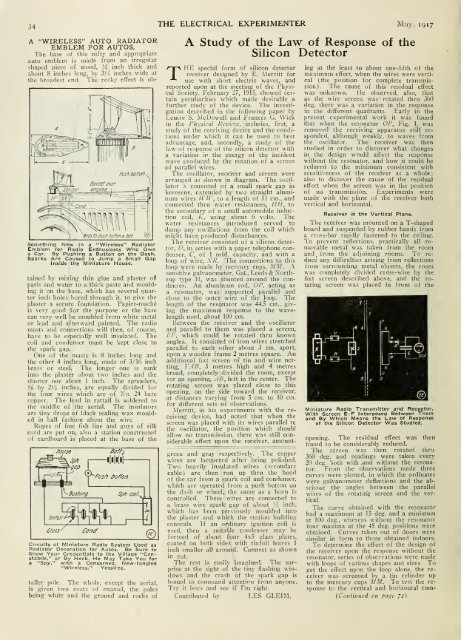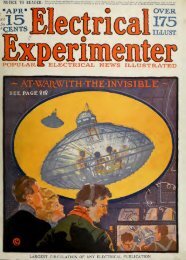The Electrical experimenter
The Electrical experimenter
The Electrical experimenter
Create successful ePaper yourself
Turn your PDF publications into a flip-book with our unique Google optimized e-Paper software.
34 THE ELECTRICAL EXPERIMENTER May, 1 917<br />
A "WIRELESS" AUTO RADIATOR<br />
EMBLEM FOR AUTOS.<br />
<strong>The</strong> base ot this nifty and appropriate<br />
auto emblem is made from an irregular<br />
shaped piece of wood, Ya inch thick and<br />
about 8 inches long, by 3^ inches wide at<br />
the broadest end. <strong>The</strong> rocky effect is ob-<br />
Ifirestopi/sfiMfonibJf. ®<br />
Something New in a "Wireless" Radiator<br />
Emblem for Radio Enthusiasts Who Own<br />
a Car. By Pushing a Button on the Dash,<br />
Sparks Are Caused to Jump a Small Gap<br />
Inside the Miniature House.<br />
tained by mixing thin glue and plaster of<br />
paris and water to a thick paste and moulding<br />
it on the base, which has several quarter<br />
inch holes bored through it, to give the<br />
plaster a secure foundation. Papier-inache<br />
is very good for the purpose or the base<br />
can very well be moulded from white metal<br />
or lead and afterward painted. <strong>The</strong> radio<br />
masts and connections will then, of course,<br />
have to be especially well insulated. <strong>The</strong><br />
coil and condenser must be kept close to<br />
the spark gap.<br />
One of the masts is 8 inches long and<br />
the other 4 inches long, made of 3/16 inch<br />
brass or steel. <strong>The</strong> longer one is sunk<br />
into the plaster about two inches and the<br />
shorter one about 1 inch. <strong>The</strong> spreaders,<br />
V% by 2^2 inches, are equally divided for<br />
the four wires which are of No. 24 bare<br />
copper. <strong>The</strong> lead in rattail is soldered to<br />
the middle of the aerial. <strong>The</strong> insulators<br />
are tiny drops of black sealing wax moulded<br />
in ball fashion about the wire.<br />
Ropes of fine fish line and guys of silk<br />
cord are put on, also a station constructed<br />
of cardboard is placed at the base of the<br />
Bafff<br />
lllllllh<br />
^Pi/i/) i>t///on<br />
Buih/ng Spk co//^<br />
r,nr}i^^i%^%^<br />
6/oss^ Corxf<br />
{e[\<br />
Circuits of Miniature Radio System Used as<br />
Radiator Decoration for Autos. Be Sure to<br />
Show Your Credentials to the Village 'Constabile."<br />
or By Heck. He May Take You for<br />
a "Spy," with a Consarned. New-fangled<br />
"Wireless." Yesslree.<br />
taller pole. <strong>The</strong> whole, except the aerial,<br />
is given two coats of enamel, the poles<br />
being white and the ground and rocks of<br />
THE<br />
A Study of the Law of Response of the<br />
Silicon Detector<br />
special form of silicon detector<br />
receiver designed by E. Merritt for<br />
use with short electric waves, and<br />
reported upon at the meeting of the Physical<br />
Society, Eebruary 27, 1915, showed certain<br />
peculiarities which made desirable a<br />
further study of the device. <strong>The</strong> investigation<br />
described in the following paper by<br />
Louise S. McDowell and Frances G. Wick<br />
in the Physical Kcviczi.^, includes, first, a<br />
study of the receiving device and the conditions<br />
under which it can be used to best<br />
advantage, and, secondly, a study of the<br />
law of response of the silicon detector with<br />
a variation in the energy of the incident<br />
wave produced by the rotation of a screen<br />
of parallel wires.<br />
<strong>The</strong> oscillator, receiver and screen were<br />
arranged as shown in diagram. <strong>The</strong> oscillator<br />
.b' consisted of a small spark gap in<br />
kerosene, extended by two straight aluminum<br />
wires U'll', to a length of 51 cm., and<br />
connected thru water resistances, HH, to<br />
the secondary of a sinall automobile induction<br />
coil. A.', using about 6 volts. <strong>The</strong><br />
water resistances introduced served to<br />
damp any oscillations from the coil which<br />
might have produced disturbances.<br />
<strong>The</strong> receiver consisted of a silicon detector,<br />
D, in series with a paper telephone condenser,<br />
C, of 1 mfd. capacity', and with a<br />
loop of wire, A'R. <strong>The</strong> connections to this<br />
loop were made by mercury cups, MM. A<br />
sensitive galvanometer, Gal., Leeds & Xorthrup<br />
type H, was shunted around the condenser.<br />
An aluminum rod, OP, acting as<br />
a resonator, was supported parallel and<br />
close to the outer wire of the loop. <strong>The</strong><br />
length of the resonator was 44.5 cm., giving<br />
the maximum response to the wavelength<br />
used, about 100 cm.<br />
Between the receiver and the oscillator<br />
and parallel to them was placed a screen,<br />
EF, which could be rotated thru known<br />
angles. It consisted of iron wires stretched<br />
parallel to each other about 3 cm. apart,<br />
upon a wooden frame 2 metres square. An<br />
additional fixt screen of tin and wire netting,<br />
VAB, 3 metres high and 4 metres<br />
broad, completely divided the room, except<br />
for an opening, AB, left in the center. <strong>The</strong><br />
rotating screen was placed close to this<br />
opening, on the side toward the receiver,<br />
at distances varying from 5 cm. to 10 cm.<br />
for different sets of observations.<br />
Merritt, in his experiments with the receiving<br />
device, had noted that when the<br />
screen was placed with its wires parallel to<br />
the oscillator, the position which should<br />
allow no transmission, there was still considerable<br />
effect upon the receiver, amount-<br />
green and gray respectively. <strong>The</strong> copper<br />
wires are lacquered after being polished.<br />
Two heavily insulated wires (secondary<br />
cable) are then run up thru the hood<br />
of the car from a spark coil and condenser,<br />
which are operated from a push button on<br />
the dash or wheel, the same as a horn is<br />
controlled. <strong>The</strong>se wires are connected to<br />
a brass wire spark gap of about 'i inch,<br />
which has been previously moulded into<br />
the plaster and which the station building<br />
conceals. If an ordinary ignition coil is<br />
used, then a suitable condenser may be<br />
formed of about four 4x5 glass plates,<br />
coated on both sides with tinfoil leaves 1<br />
inch smaller all around. Connect as shown<br />
in cut.<br />
<strong>The</strong> rest is easily imagined. <strong>The</strong> surprise<br />
at the sight of the tiny flashing windows<br />
and the crash of the spark gap is<br />
bound to command attention from anyone.<br />
Try it boys and see if I'm right.<br />
Contributed bv LES GLEIM.<br />
ing at the least to about one-fifth of the<br />
maximum effect, when the wires were vertical<br />
(the position for complete transmission).<br />
<strong>The</strong> cause of this residual effect<br />
was unknown. He observed, also, that<br />
as the wire screen was rotated thru 3bO<br />
deg. there was a variation in the response<br />
in the different quadrants. Early in the<br />
present experimental work it was found<br />
that when the resonator OP, Fig. 1, was<br />
removed the receiving apparatus still responded,<br />
although weakly, to waves from<br />
the oscillator. <strong>The</strong> receiver was then<br />
studied in order to discover what changes<br />
in the design would affect the response<br />
without the resonator, and how it could be<br />
reduced to the minimum consistent with<br />
sensitiveness of the receiver as a whole;<br />
also to discover the cause of the residual<br />
effect when the screen was in the position<br />
of no transmission. Experiments were<br />
made with the plane of the receiver both<br />
vertical and horizontal.<br />
Receiver in the Vertical Plane.<br />
Tlie receiver was mounted on a T-shaped<br />
board and suspended by rubber bands from<br />
a cross-bar rigidly fastened to the ceiling.<br />
To prevent reflections, practically all removable<br />
metal was taken from the room<br />
and^ from the adjoining rooms. To reduce<br />
any difficulties arising from reflections<br />
from surrounding metal objects, the room<br />
was completely divided cross-wise by the<br />
fi.xt screen described above, and the rotating<br />
screen was placed in front of the<br />
Miniature Radio Transmitter and Receptor.<br />
With Screen E-F Interposed Between <strong>The</strong>m<br />
and By Which Means the Law of Response<br />
of the Silicon Detector Was Studied.<br />
opening. <strong>The</strong> residual effect was then<br />
found to be considerably reduced.<br />
<strong>The</strong> screen was then rotated thru<br />
360 deg. and readings were taken every<br />
20 deg. both with and without the resonator.<br />
From the observations made three<br />
curves were plotted, in which the ordinates<br />
were galvanometer deflections and the abscissae<br />
the angles between the parallel<br />
wires of the rotating screen and the ver-<br />
tical.<br />
<strong>The</strong> curve obtained with the resonator<br />
had a maximum at 15 deg. and a minimum<br />
at UK) deg.. whereas without the resonator<br />
four maxima at the 45 deg. positions were<br />
obtained. Curves taken out of doors were<br />
similar in form to those obtained indoors.<br />
To determine the effect of the design of<br />
the receiver upon the response without the<br />
resonator, series of observations were made<br />
with loops of various shapes and sizes. To<br />
get the effect upon the loop alone, the receiver<br />
was screened by a tin cylinder up<br />
to the mercury cups -l/.l/. To test tlie re-<br />
.sponse to the vertical and horizontal com-<br />
(Contiiiucd on page 74)




